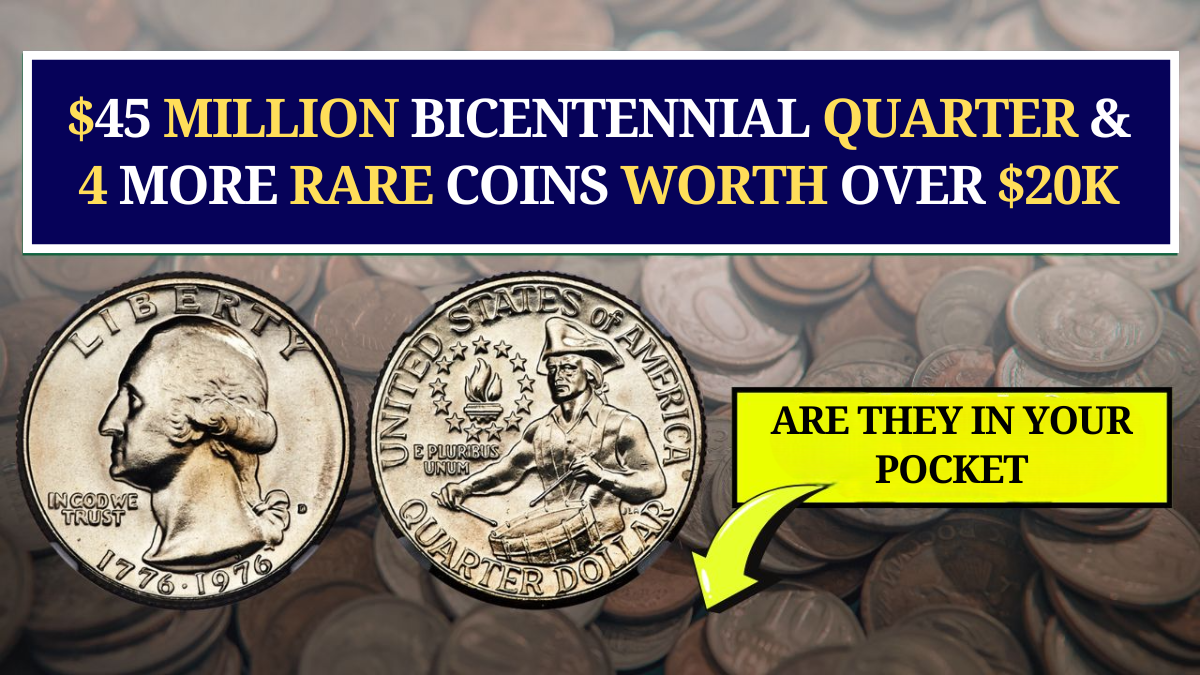A coin in your pocket money that could earn you a fortune sounds dreamy, doesn’t it? But it could just become reality. Among the world’s most valuable and least common coins is said to be a Bicentennial Quarter valued at an eye-watering $45 million.
In addition to it, a number of other U.S. coins have been worth more than $20,000 each, frequently because of historical importance, mint mistakes, or extremely low circulation. Let’s venture into the realm of precious coins still lurking in plain sight and how to identify them.
1. The $45 Million Bicentennial Quarter – The Crown Jewel
The Bicentennial Quarter, coined in 1976 to celebrate 200 years of U.S. independence, is a well-known coin. Yet, one variation of this quarter is said to be worth as much as $45 million, mostly due to its special mint error and composition anomaly.
Why Is It Worth So Much?
- Error Coin: A few of these quarters were minted on a silver planchet instead of the standard copper-nickel mixture.
- Mint Marks: Find an “S” mint mark that it was produced in San Francisco, where most proof coins were struck.
- Double Die Obverse: Some have doubling in the date or the word “Liberty,” a strong indicator of rarity.
This quarter has a drummer boy design on the back and a double date, “1776–1976.” The most valuable ones tend to be in mint, uncirculated condition and were probably part of special proof sets.
2. 1943 Copper Penny – Worth Over $100,000
The U.S. Mint in World War II changed from copper to zinc-coated steel pennies to save copper for the war. A small number of copper pennies were accidentally struck in 1943 using the old metal.

Key Identifiers:
- Date: 1943
- Metal: If it appears to be a normal penny and won’t stick to a magnet, it may be copper.
- Rarity: Less than 20 known to exist.
These coins are extremely scarce and are worth $100,000 or more, depending on their condition.
3. 1894-S Barber Dime – The Million-Dollar Dime
There were only 24 made, and fewer than 10 exist today, making the 1894-S Barber Dime one of the rarest coins in U.S. history.
Why It’s Valuable:
- Made in San Francisco (S mint mark)
- Very low mintage
- One sold for more than $2 million at auction.
While it’s doubtful you’ll ever see this coin in your change, it’s still among the most discussed rarities in U.S. coin collecting.
4. 1913 Liberty Head Nickel – A $5 Million Marvel
The 1913 Liberty Head Nickel is a legend among coins. There are only five known, and each has an interesting history.
Distinctive Features:
- No documented record of them being officially made
- Five verified specimens
- One sold for $5 million in a private sale.
This coin’s ancient history and mystery of creation render it as one of the least common American coins ever made.
5. 2004 Wisconsin Extra Leaf Quarter – $6,000+
This coin looks completely average at first sight. But there are two unique variations of the 2004 Wisconsin quarter, “Extra Leaf High” and “Extra Leaf Low.”

Look For:
- Extra leaf on the back of the coin close to the corn stalk
- Found predominantly in Wisconsin and surrounding states
- Worth $1,000 to $6,000+
This is a newer coin that you would actually be likely to find circulating today, and as such is a favorite with amateur collectors and treasure hunters alike.
Why Are These Coins So Valuable?
How a coin’s value is calculated is based on several factors:
- Rarity: The fewer the number of coins in existence, the more valuable they are.
- Condition: Mint or near-mint condition coins are worth more.
- Errors: Mistakes during the minting process give coins individuality and collectibility.
- Demand: Popular coins with good stories behind them can generate collector demand.
How to Check If You Have a Valuable Coin
- Look at the date and mint mark: special years or particular mint marks (D, S, or none) can add worth.
- Search for Errors: Doubling, off-center strikes, or misattributed metals are indicators of a rare coin.
- Use a Magnet: Certain counterfeit coins are magnetic where they shouldn’t be—or vice versa.
- Consult a Coin Guide: Use official coin catalogs or online resources such as PCGS, NGC, or the Red Book.
- Get an Appraisal: If you believe you’ve discovered a rare coin, consult a professional appraiser or grading service.
Read More :- $70,000 Barber Half Dollar Discovered in Circulation – Learn How to Identify This Treasure!
Where Can You Sell Rare Coins?
- Auction Houses: Establishments such as Heritage Auctions or Stack’s Bowers frequently handle rare coins.
- Certified Coin Dealers: Find dealers who are registered with groups such as the ANA (American Numismatic Association).
- Online Marketplaces: eBay is possible, but be careful because there can be scams.
- Coin Shows and Conventions: Excellent for networking, appraisals, and face-to-face sales.
Final Thoughts: Check Your Change!
While discovering a $45 million quarter might sound like fantasy, history shows that unusual coins do turn up in regular circulation. The trick is awareness and attention to detail. Collectors and enthusiasts both are aware that fortunes can be discovered in the most unlikely of places sometimes in your pocket.
Whether you’re a recreational coin checker or a professional numismatist, it’s worth taking a closer examination of your change. Who knows? That plain-looking coin could be concealing a rare and valuable secret.
FAQs:-
What is the $45 million Bicentennial Quarter?
It’s a rare 1976 quarter with a unique minting error or rare composition. Its rarity and condition make it highly valuable to collectors.
How can I identify the $45 million Bicentennial Quarter?
Look for sharp details, no wear, a “D” or “S” mint mark, and unusual errors or double die strikes.
What is the best way to store rare coins?
Keep them in acid-free holders or coin flips and store them in a cool, dry place away from direct sunlight.










